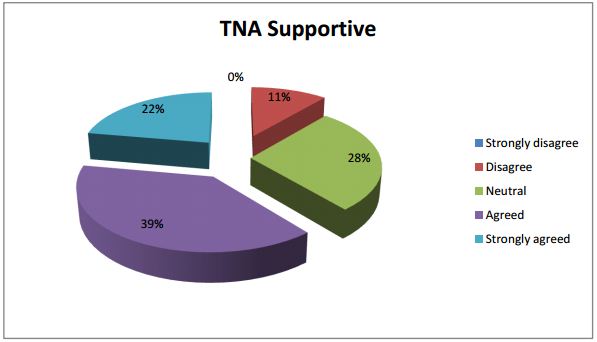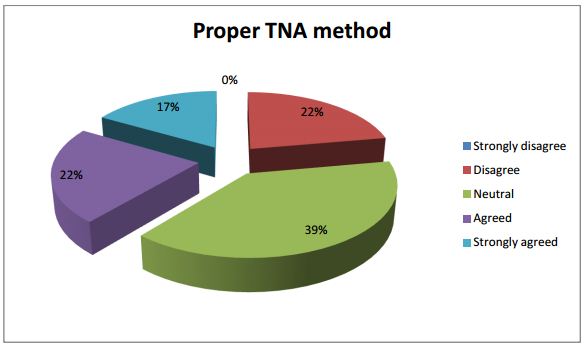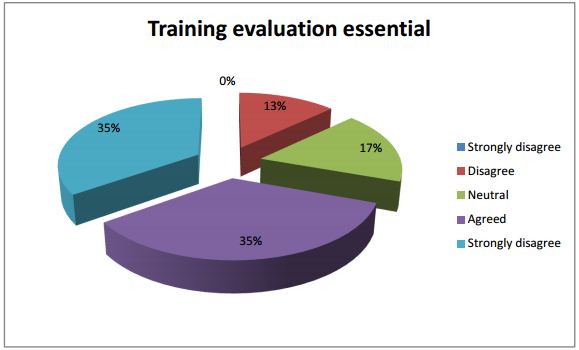Attitude Measurement of Employees on Training Process towards
Human Resource Division of BRAC Bank Limited
Growth of a country depends a lot on the Banking industry and it is one of the potential industries. Banking industry in Bangladesh is also very influential. We have many skilled employees in this industry, as it is a big industry. Therefore, Human Resource Management (HRM) is much valid as well as proficient in the banks of Bangladesh. BRAC Bank Ltd. has reached to the market to boost up the banking system. BRAC Bank Ltd. has developed a skilled and efficient workforce to complete the global challenge. The HR department of BRAC Bank Ltd. manages this large employee force fully. The HR department meets the entire necessities of the recruits from remuneration to rewards, hiring to firing recruits and further significant and essential development trainings.
This report has two parts: one is delineating theoretical aspects of HRM, broadly described training and development process and procedures of training and development in BRAC Bank Ltd. To know the details of the company we interviewed some HR personnel of BRAC Bank Ltd. and other information were collected and gathered with the help of internet. BRAC Bank Ltd. is the organization where actually the HR activities are applied with a huge effort, and the outcome is very satisfying.
Since the independence of Bangladesh, BRAC Bank Ltd. conducted their operations as it has a very strong network throughout the country. In addition, they got huge employee networks, with huge operations. However, due to the failure in their strategic decision and inefficient management of employees BRAC Bank Ltd. Lagged behind in the last few years. The report shows how they are ineffective in employee management in regard of training and development procedure. Their Training Need Assessment (TNA) comes as complete vague and total failure. The methods that they formulate in action are not enough to support employee development. BRAC Bank Ltd. still has a better opportunity to fight back against all odds. BRAC Bank Ltd. has to follow the standard that they prepare for training methods in order to maintain the employee satisfaction and employee development. Employees should be rewarded based on their performance. TNA should be formalized, followed, and should be clear enough to all the employees and how it links to organizational goal.
Objective of the study
The general objective of the report is to explore the training and development program of BRAC Bank Ltd.
Specific objectives:
- The specific objectives of the learning are as follow:
- To identify the purpose of training of BRAC Bank Ltd.
- To analyze the needs assessment process of training and development program of BRAC Bank Ltd.
- To understand the training and development methods of BRAC Bank Ltd.
- To evaluate the process of training and development program of BRAC Bank Ltd.
Overview of BRAC Bank Ltd.
With a broad and associate network present all throughout the country with both local and international institution shareholders BRAC Bank Ltd. (BBL) is known the most active and influential private bank in Bangladesh. The journey of BRAC Bank Ltd. started on July 2001. However, the bank is now highly motivated with a view of creating opportunities and pursuing market niches. BRAC Bank Ltd. has been aggravated to present the „best-in-the-class‟ services to its miscellaneous variety of customers spread across the country under an on-line banking dais. BRAC Bank Ltd. is one of the fastest growing and modern banks of Bangladesh, and is playing a fundamental responsibility as financial mediators connecting between the economic policies of the government with the rest of the economy.
Being a local bank and serving the banking need of the local people, Human Resource Division of BRAC Bank Ltd. maintain an accustom human resources management strategy and the division comprises of Recruitment, Compensation and Benefits, Learning and Development, Human Capital Development and HR Administration Department with a team of HR Relationship Managers who bridge HR support with the business needs.
BRAC Bank Ltd. is formerly SME (Small and Medium Enterprise) focused bank, which is playing a vital role in the socio economic, industrial and agriculture development together with the overall economic development. SME banking division is a supplementary and specialized horizon of the bank which serves the bank‟s special focus in promoting broad based participation by catering to the small and medium entrepreneurs and this network of SME has already been established throughout Bangladesh.
BRAC Bank Ltd. has institutional shareholdings by BRAC, International Finance Corporation (IFC) and Shore cap International, has been the fastest growing Bank from 2004 to 2007. The Bank operates under a “double bottom line” agenda where profit and social responsibility go hand in hand as it strives towards a poverty-free, enlightened Bangladesh. The management of BRAC Bank Ltd. believes that the sector of the economy can contribute the most to the rapid generation of employment in Bangladesh.
Human Resource Management
Every organization or institute is composed up of people, acquiring of the services, boosting up the skills, inspiring the human resources to high level of performance, and ensuring that they persist to maintain their commitment to the organization which are needed in achieving organizational objectives as Human Resource Management (HRM) which is basically concerned with the people dimension in management.
Those organization that are able to attain, develop and expand, stimulate, and maintain exceptional human resources will be mutually effective and efficient.
Survival of any organization requires proficient and competent management and work force coordinating their efforts in the direction of an ultimate goal.
Human Resource Management is an overall set of organizational activities directed at attracting, developing and maintaining and regulating an effective workforce.
Objectives of Human Resource Management
HRM has some specific objectives by which organization are benefited to be successful in attaining their goals. The objectives are given below:
To help the organization reach its goals:
The HRM helps the organization to reach its target. Organization achieves their goals by the utilization of resources. Human resource utilizes all other resources without which an organization can never reach its goals.
To achieve effective utilization of human resources:
Human resources are to be nature, motivated, encouraged contributing their best to the organization. The objective of HRM is to develop, expand and utilize all avenues to specify the human resources.
Employ the skills and abilities of the workforce:
HRM is to build and protect the most valuable asset, people in the organization. This entails that human skills and abilities are to tracked rightly, bridge the gaps with realities and place them in the most competent jobs so that they can best use their skills and abilities.
To provide the organization with well-trained and well-motivated employees:
The objective of HRM is to enhance the required skills and potential abilities through training and development processes.
To increase employee’s job satisfaction and self-actualization:
The human potential has an ability that is occupied only when they are pleased with the jobs and feel a sense of belongingness and fulfillers with their organization.
To achieve quality of work life:
The HRM is to develop and sustain a superiority of work life that makes employment in the organization desirable. Quality of work life includes harmonious management and supervisory style, freedom and autonomy in decision-making, satisfactory and acceptable psychological condition, working hours and meaningful jobs.
To communicate HRM policies to all employees:
Communication is an effective tool to know about the intentions of internal and external human bodies with which organization has at least some amount of interest. The internal HR communicates with polices programs and actions, which are relevant to their interest.
Functions of Human Resources Management
Within the functional area of human resources management, a huge number of activities must be proficient so that the organization‟s workforce can come up with an optional attribution to the organization‟s success. There are four basic function of human resources management (HRM):
- Acquisition Function
- Training & Development
- Motivation
- Maintenance
Acquisition Function:
Acquisition function deals with the planning of the human resources. It includes job analysis, recruitment, selection and socialization.
Human Resources Planning:
Human Resource Planning is the process that helps to provide a good number of adequate workforces to achieve their target.
Job analysis:
One can identify the duties of the positions in the organization and the characteristics of the people to hire for them by the process of job analysis..
Job analysis methods:
Job analysis is the methods that managers can identify in order to determine job elements, abilities, knowledge, skills and necessary performance. They may include the following:
- Observation method
- Individual interview method
- Group interview method
- Structure questionnaire method
- Diary method
- Job analysis process:
- Functional job analysis
- Position analysis questionnaire
Purpose of job analysis:
- Job description
- Job specification
- Job evaluation
Recruitment: It is the process of findings and attracting qualified people for job.
There are 2 types of recruitments. They include:
Internal recruitment channel:
- Job posting programs
- Departing employees
External recruiting channel:
- Walk-ins and write-ins
- Employee referrals
- Advertising
- Educational institutions
- Professional associations
Selection:
Selection process is a series of specific steps that helps the managers to decide which recruits to hire. This process begins when recruits apply for employment and ends with the hiring decision.
Steps in the selection process:
Step 1: Preliminary reception application
Step 2: Employment tests
Step 3: Selection interview
Step 4: Reference and background checks
Step 5: Medical evaluation
Step 6: Supervisory interview
Step 7: Realistic job preview
Step 8: Hiring interviews
Training and Development:
The function of human resources management includes Training and Development
Training: Training is a method of developing certain attitudes, actions, skills and abilities in employees.
Development: Development helps to handle future responsibilities with little concern for the current job. The individual handle future responsibilities, with little concern for current job duties.
Training methods:
There are two types of training methods, which includes:
- On the-Job Training
- Off the-Job Training
Motivation:
Motivation is the process that account for the individuals intensity, direction and persistence of effort toward attaining a goal.
Motivation in human resources management includes:
- Job design
- Performance Evaluation
- Rewards
- Job evaluation
- Compensation
- Discipline
An employee’s job performance can be sorted as being determined by the level and interaction between ability and motivation.
Maintenance:
The objective of this function is to retain people who are performing at high levels.
This requires that the organization provide. Safe and healthful working condition along with satisfactory labor relations refers to a proper maintenance levels which is required in each and every organization.
This function includes:
- Compensation administration
- Benefits and services
- Safety and health
- Labor relations
- Collective bargaining
- Discipline
Socialization: It is a development of getting new employees acquainted with the organization, its rules and regulations, culture, objectives and supervisors and other employees.
Socialization Process:
- Organization‟s Individual‟s
- Culture & Values Personality
Socialization through orientation:
Orientation helps in introducing a new employee to the organization and to his or her working unit. It usually expands upon the required or given information received during the recruitment and selection stages which helps the managers to know the new employee.
Learning
After the orientation, training of the employees takes place after orientation takes place. Training is the process of enhancing the skills, capabilities and knowledge of employees for doing a particular job. Training process modules the thoughts and views of employees that in return leads to quality performance of employees. Training programs are not necessarily always about works, it can also be about things related to work such as fire drills, first aid training for the office, earthquake drills and much more.
SOCIALIZATION PROCESS
Education, personal development; schooling or training is a part of human learning. It may be goal-oriented and may be aided through motivation. Learning may occur because of habituation or classical conditioning.
Employee training is usually referred to programs that provide information to the workers, new skills or professional development opportunities. Depending on the matter of the subject, training might be executed by the staff members or by outside consultants.
By hiring new employees, organizations go through a training period, prior to being assigned major job duties. This specific training is usually intendment to orient them to the position and to give them information they need to carry out their daily responsibilities. Part of this orientation could include meeting with the staffs and learning administrative tasks, such as filing paper work. They might also be prepared with mentors who can illustrate how to perform more specific job functions. A related strategy, called on-the-job training, allows new employees to learn their jobs as they do them.
Training Methods:
On-the-job training (OJT) is a form of a training taking place in a normal working situation. On–the-job training, sometimes called direct instruction, is one of the earliest forms of training.
On-the-job training is still widely in use today. In fact, it is probably the most popular method of training because it requires only a person who knows how to do the task, and the tools the person uses to do the task. It may not be the most effective or the most efficient method at times, but it is a normally the easiest to arrange and manage.
Because the training tasks place on the job, it can be highly realistic and no transfer of learning is required. It is often inexpensive because no special equipment is needed is other than what is normally used on the job. On the other hand, OJT takes the trainers and materials out of production for the duration of the training time. In addition, due to safety or other production factor, it is prohibitive in some environments.
Off-the-job training method takes place away from normal work situations implying that the employee does not count as a directly productive worker while such training takes place. Off-the-job-training method also involves employee training at a site away from the actual work environment. It often utilizes lectures, case studies, role playing and concentrate more thoroughly on the training itself. This type training has proven more effective in allocating concepts and ideas.
Executive Development
In some organizations, there is a separate executive development team, in other organizations executive development that is handled as one of many activities by the larger corporate training group, and yet other scenarios there is no executive development activity to speak of.
In contrast to other corporate training and development activities, which have as their core principle to build strategic skills for employees, executive development plays a special role for the organization. Indeed some executive development is conduct for building strategic skills, yet executive development is also used to evaluate future potential, future executives as well as a mechanism for the CEO and the executive team to cascade their strategies, goals, and even elements of the culture to the rest of the management team and eventually the organization. In the best of cases, executive development not only helps an organization execute its key strategies, it can also help endow with input to the strategy creation process.
Difference between Training and Development
Training is a process of learning a sequence of programmed behavior. It improves the employee’s performance on the current job and prepares them for an intended job. Training is a short-term process, which refers to instruction in the technical and mechanical problems. Therefore, training has a specific job related purpose.
Development not only improves job performance but also brings about the growth of the personality. Individuals not only mature regarding their potential capacities but also become better individuals. Development is a long term educational process which refers to philosophical and theoretical educational concepts. Therefore, it is a knowledge-based purpose.
Purpose of training
- To improve productivity: Training leads to increased operational productivity and increased company profit.
- To improve Quality: Better-trained workers are less likely to make operational mistakes.
- To improve Organizational Climate: Training leads to improved production and product quality that enhances financial incentives. This is turn increase the overall morale of the organization.
- To increase Health and Safety: Proper training prevents industrial accidents.
- Personal Growth: Training gives employees a wider awareness, enlarged skill base and that leads to enhanced personal growth.
Purpose of development
Management development attempts to improve managerial performance by imparting
- Knowledge
- Changing attitudes
- Increasing skills
The major objective of development is managerial effectiveness through a planned and a deliberate process of learning. This provides for planned growth of managers to meet the future organizational needs.
Importance of Training & Development
The training and development is an ongoing process in BRAC Bank Ltd. With personal and professional development of talent seen as top priority. A part from in house training BRAC Bank Ltd. Human Resources Division offer on the job and the job both theoretical and practice levels training and development opportunities provided through a rage of local, regional and international training programs that include training and development programs at functional, operational and managerial capacity.
The Purpose of Training of BRAC Bank Ltd.
BRAC Bank Ltd. offers broad diversity of training programs in order to guide and achieve three basic goals, which includes:
- Improvement of the Performance
- Enhancing Morality
- Deliver Measurable Results
Improve Performance
In order to improve the performance, BBL wants to know few specific things: How employees are performing currently; and how BBL wants them to perform tomorrow.
Performance improvement is the procedure to measure the output of a particular process, then modifying and organizing the procedure to enhance the output, enhance the level of efficiency, or increase the level of effectiveness of the procedure. It can be applied to either individual performance or a group or team based.
In BBL, the development process of performance improvement is the key concept of BBL, in which the managers and governing body of BBL put into a set and manages a program, which measures the existing level of performance of the BBL and then generates ideas for modifying BBL performance and infrastructure, which are put into a position to achieve higher output. The primary goals of BBL improvement are to increase the level of effectiveness and efficiency to develop the ability of the BBL to deliver goods and or services.
Enhance Morale
BBL wants their employees to enhance employee morale in order to get better service that they desire from their employee. Proper training is provided to the employees for the betterment of quality service.
Deliver Measurable Results
One of the main goal of training is to deliver a proper measurable result. BBL tries to state the training goals much cordially and it measures the outcomes of work against employee success. This helps to identify the impact of the program, and the learning is feedback into BBL without any additional cost.
These three common goals illustrate their broad training objectives. However some of their broad objectives are:
Customer Services
Better customer service might drive the employees to be better BBL. In this regard, BBL constantly supports in training session to guide and improve superior customer service.
Retention
BBL’s employees have no fear of losing job, but BBL‟s authority tries to support their employees by proper training.
Efficiency
To increase the employees’ efficiency in the working field, employees should be given proper training.
Growth
Better work experience leads an employee to get promotion.
Process of Training and Development
Employee training is one of the core responsibilities of BBL. Employee expansion is a collective responsibility of an organization and the individual employee. The responsibility of any organization is to endow with the right resources and environment that support the growth and development needs of the individual employee.
For employee training and development to be successful:
- BBL provides training that is required by the employees to reach the basic competencies for the job.
- BBL looks for learning opportunities in day-to-day activity. Some of the relevant questions which may hit them includes: Was there an incident with a client that everyone could learn from? Is there a new government report with implications for the BBL?
- BBL explains the employee enlargement process and persuade workforce to develop individual development plans.
- BBL supports staff they identify learning activities that make them an asset to it both now and in the future.
For employee development to be successful, the individual employee should:
- Look for learning opportunities in everyday activities.
- Identify goals and activities for development and prepare an individual development plan.
The individual development planning process:
The employee in partnership prepares an individual development plan with his or her supervisor. The plan is generally based upon the needs of the employee, the position and the BBL. A good individual development will be interesting, achievable, practical and realistic. It is implemented with the approval of the employee‟s supervisor.
Training Needs Assessment (TNA) of BRAC Bank Ltd.
Without the right skills and targeted investment in learning and development, an organization cannot compete successfully. A carefully designed and implemented training needs analysis can prevent critical skills shortages and gaps as well as allocating resources to potentially ineffective learning and training programs.
There are some ways, which is followed by the BBL‟s employee for the need analysis:
Self-assessment
Self-assessment is a technique, which an employee uses to identify his or her skills, strengths, weaknesses, and values. Self-assessment tools should be used in order to assess themselves. Comparing the skills, knowledge and abilities with the specific job description. Last but not the least is the supervisor’s feedback.
Position assessment is also being conducted to fulfill the requirements of the employee’s current position. Job requirements should be identified along with the performance expectations. Identifying the skills, abilities and knowledge that highlights the ability to perform in the current job.
Task analysis
Building the training task is like constructing a detailed model of what needs to be covered. Fundamentally, BBL lays out what the trainers need to know and how it will go about teaching the employees.
Once the employees are comfortable with their own knowledge level, BBL constructs the steps necessary for teaching them which includes:
- Breaking the job into major functions.
- Breaking the functions into major tasks.
- Breaking the tasks into different steps.
- Identifying training outcomes.
- Need Assessment Techniques for the Operatives and Fresher
The process that BBL follows to identify the training needs for operatives and fresher is following three different stages and raising some questions, which are showing chronologically:
- To determine what training is appropriate for the employee’s jobs.
- To determine what training will improve the performance of the employee.
- To determine if training will make any difference.
- To identify the training needs from BBL problems.
- To link improved job performance with the BBL‟s goals and bottom line.
Step1: Define the problem
Determining the relevant training program for the new employee to improve their performance.
Step2: Is it important?
Determining whether it is going to make or bring any change to the new employee while working in BBL. Formulating the changes it would make.
Step 3: Determine Cause(s)
Determining the problem in depth, whether it is a problem of will or skill. If it is a deficiency of skill, then take necessary action against it.
Step 4: Arrange Formal Training
After determining, the deficiencies of skill take proper action by arranging formal training for the new employees. Thus, it would help the trainers to come up with different ideas of how to develop them in their own training methods.
Step 5: Arrange Practice
Practice makes a man perfect. The more you practice, the more you get expert in something particular. Training helps the employees to make themselves perfect in some ways by being train by the most expert trainers.
Step 6: Arrange Feedback
After receiving the training, the new employees are given an examination, where they have to pass in order to work for BBL. Thus, it helps both the organization as well as the employee to judge themselves in order to serve for the bank.
Need Assessment Techniques For The Executives:
Executives in BBL receives training in a regular basis in time interval, formal trainings are given in timely basis. They wanted to introduce online basis banking which remarks to train some of their employees for their betterment.
Training and development methods followed in BRAC Bank Ltd.
BRAC Bank Ltd. recognizes Human resources development as one of the core part in any BBL sustainability, growth, development and expansion.
Activities:
BBL conducts various courses, executive development programs and workshops, mainly for Officers and executives of the bank. BRAC Bank Ltd. is devoted to develop the human resources, which is the main driving strength of the bank through structured modular training programs.
Training & Development Program:
Staff Development & Training:
Training refers to the acquirement of knowledge, information, skills and competencies. Today it is often referred to as professional development concerned with workplace learning to improve performance.
Major Responsibility of Training Wing:
Major responsibility of training wing is to ensure minimum 30 hours training sessions in a year for the permanent employee.
Need Based Training Course:
Need based training course focus on development of general knowledge and skill corporate executives.
Skill Based Training Courses:
Skill based training courses focuses on skill development and improvement of the respective desk related activities such as computer literacy, analytical ability, loan processing, reporting techniques, credit analysis, etc.
Training Methods for the Fresher
Classroom training:
Courses, Seminars, Workshops
These are formal training opportunities offered to employees either externally or internally. A trainer or facilitator who is an expert can be brought into BBL to provide the training session. The employee can either be sent to one of these learning opportunities during work time. BBL provides it within their own trainer some while they send outside or hire external for the new employees.
Mentoring:
Mentoring is more or less related to coaching. Mentoring follows when BBL‟s experienced manager, seniors and experts provides guidance, regulation and advice to any junior employee.
Job shadowing:
A new or existing employee might want to learn or follow what their colleagues are doing by observing their work. This helps them to know the other roles that are played in BBL. This helps to gather more knowledge about the bank itself and how things should be done.
Critical incident notes:
Activities which are done on daily basis are always a source of learning opportunities for the employees of BBL. Self-effort learning process which are created by the employees from critical incident are practiced by these employees. This in return helps to improve in the areas they are behind.
Conferences and forums:
Employees attend the conference that focuses on relevant topic that goes with their position. After this, the employees make their own presentation in enhancing the learning experience. Therefore, at the end of a specific period the employees call for a conference.
Committees:
Committees are a major activity part in BBL. These committees are made up of work force from different areas of BBL, which are a great beneficent for the banks.
Training methods for the executives
Job expanding:
The respective managers decide and assign the job duties of the specific employees.
Therefore, when the employees are successful fulfilling their specific tasks they get the floor to challenge something greater.
Job rotation:
On a short period basis, employees should be given the chance to work in different area of BBL. This helps them to get to know the responsibilities of their colleagues.
Stretch assignments:
These stretch assignments furnish the employee and prospect to stretch past his or her current abilities. This helps them to evaluate themselves and identify necessary things that need to be improved.
Survey Analysis and Major Findings
Questionnaire survey Analysis
A .Training Need Assessment is supportive for your organization to identify the training objectives and formulate the training program.

Figure: Training Need Assessment Support
Here we see that 39% of the respondents agreed and 22% respondents are strongly agreed, 28% respondents were neutral, and 11% respondents disagreed about this statement.
The organization can easily understand the training needs of the employees; moreover, they know how TNA works and is essential for the organization. The employees sometimes feel that TNA is not supportive for identifying organizational goals. The graph here shows all stories towards TNA.
B. The organization follows a specific TNA method to achieve the training objectives.

Figure : Proper TNA Method
In this statement 39% of the respondents were neutral that organization follows a specific TNA method, 22% respondents disagreed, 22% respondents agreed and 17% respondents strongly agreed about the impact of specific TNA method to achieve the training objectives.
Maximum employees are not highly informed about well dressing on TNA procedure for which employees kept neutral. This might not be a good sign; employees should be well clued-up about TNA.
C. Training methods applied in the organization is satisfactory and effective.

Figure : Proper Training Method
Here we see that 36% of the respondents disagreed about the statement, 29% respondents were neutral, 21% respondents agreed and 14% respondents were strongly disagreed about the training methods applied in the organization.
Satisfaction on training is highly depending on training method, the consistency of similar process of training method might not increase employee satisfaction.
D. Training evaluation is an essential function to achieve the training objectives

Figure: Training Evaluation Essential
Here we can see that 35% of respondents agreed and strongly agreed that training evaluation is essential function to achieve the training objectives, 13% respondents disagreed, and 17% respondents were neutral about the statement.
The main objectives of training evaluation are clearly associated to the training goals, which are precise by the training evaluation procedure. Here we see that huge amount of employees agreed with this statement.
SWOT Analysis of BBL’s Training Program
Strengths
BRAC Bank Ltd. has a number of strengths. As BBL has a very huge training center along with a huge potential of efficiency, the internal experts are very much proficient of providing guidance and training to the trainees. BRAC Bank Ltd. can provide training to a huge number of employees that in return saves a lot of time. These expert trainers are highly renowned among the banking sectors that make the training of BBL more prominent. Therefore, having a huge number is the biggest strength for BBL, because it influences as the opportunity in the career growth.
Weaknesses
As the training center of BBL is not so remarkable, it is the greatest weakness for BBL. Therefore, the equipment they use for the training purpose is not updated or modern, which one of the biggest lacking for the bank.
Opportunities
The trainers who are experts can even be trained outside of BBL, which is the biggest opportunity for the employees.
Threats
The experts from BBL can switch their jobs in search of better opportunities, which can be a major threat for BBL. Therefore, other commercial or multinational banks around the country are already using modern equipment for the training purpose.
Major Findings
BBL is one of the most renowned banks in Bangladesh. It is very much prominent for the training it gives to its employees. However, out of all these it has few demerits that need to be figure out as soon as possible. The Training Need Assessment (TNA) is of a good standard. The resources they use during the training period are old and obsolete. As they maintain a similar and constant process of training, it hampers the satisfaction of the employees and as a result, they are not motivated to have the training session. However, the questionnaire survey gives us a vast analysis of the overall training process of BRAC Bank Ltd.
Recommendations
- Training evaluation procedure must be clarified and specified.
- Organizations mission and vision has to be clarified to all employees in regard to be clarified of training goals.
- Training methods should be friendly and flexible depending on individual capacity.
- Employees should be clearly stated the training goals.
- BBL should formulate tools to measure the trainer‟s abilities.
- Training methods should be encouraged to be two-way communications.
- TNA should formalize and followed and made it clears to all employees how it links to organizational goal.
- Training institution should be more decentralized.
- Employee ought to be given more rewards, based on their performance.
- Training tools that are modernized and updated should be used.
- Training evaluation should be more specific and measurable.
Conclusion
BRAC Bank Ltd. has to convert to all of their training system and policy of traditional banking in to a modern system. As they have huge opportunities in case of large number of branches and employee number. The modernization and digitalization might come them very a very strong chance to lead the banking sector. I think which might be a practical and bold decision. There are lots of local and foreign bank in Bangladesh; the BRAC Bank Ltd. is one of the promising private bank among them.
In this competitive market, BRAC Bank Ltd. has to struggle not only the other commercial banks but also the other public commercial bank. BRAC Bank Ltd. Is much more capable of number of employees. If it invests more funds in training and development and proper procedure to utilize them, it will like leading company. It is obvious that the right thinking of this bank including establishing a successful network over the country and increasing resources will be able to play a considerable role in the portfolio of development. Success in the banking business largely depends on effective nursing of human resource into real resource not the member of just human.
















